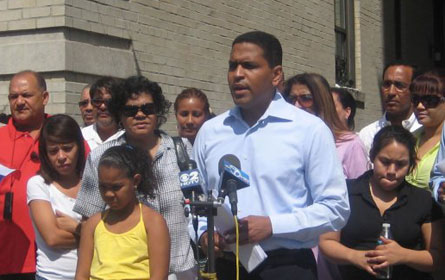Tony the Stowaway
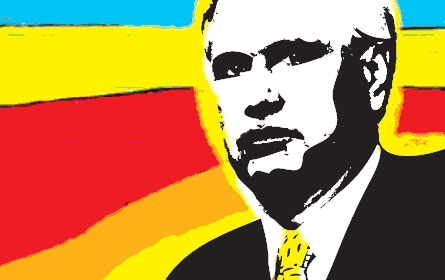

This is the second story in our series on the mayoral candidates. Read the first story: The Underdog.
Councilmember Tony Avella's campaign headquarters is fitting.
Located on the middle floor of a storage facility that's practically on top of the Brooklyn Queens Expressway, it's an elusive setting to kick off a run for the city's top office.
When I visited last week, the Prince Street sign teetered on its hinges, the Q train crossing the Manhattan Bridge rumbled in the distance and a likely homeless man marched in the vacant lot next door, dragging a large wooden stick. Just flights up inside, a quote from Mahatma Gandhi hung in one room, a bubble-lettered campaign schedule in the other. Another hand-written poster read: "Viva Avella."
In the flesh, Avella was berating his newest target: William Thompson Jr. The city comptroller is Avella's opponent in the September Democratic primary and the latest addition to Avella's all-too-powerful-politician list. That list has long starred Mayor Michael Bloomberg and Council Speaker Christine Quinn.
The councilman-slash-mayoral candidate's latest grievance: Thompson's call for the resignation of city schools Chancellor Joel Klein -- a stand Avella said he himself took years ago.
"I guess [Thompson's] getting worried that I'm getting closer in the polls and now he is in fact copying what I have said," Avella argues, with a hint of hauteur in his voice. "I have no problem calling him copy cat Thompson." He laughs, then calls to his communications director: "We should start calling him out. Where are the original thoughts?"
Originality, according to Avella, is his campaign's modus operandi.
Avella claims his run for mayor might break boundaries. With barely any cash on hand (just 5 percent of what Thompson has raised and .007 of what Bloomberg has spent), Avella is banking on good, old fashioned word of mouth to get him into the west side of City Hall. "This," Avella exclaims, throwing his arms up, "has never been done before."
So far, though, "this" has showed little sign of success. Operatives, advocates, council members and even his own allies don't think this city's official pre-McCain maverick stands a chance. What his campaign might do, they say, is shine a spotlight on the issues central to the Avella platform: the city's so-called run amok development and the lack of community input.
Unintentionally, the Avella campaign's supreme impact may be giving the councilman's archrival of the moment a leg up after the Democratic primary.
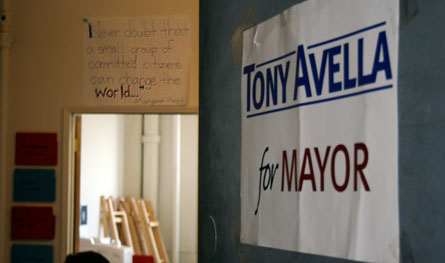
A Man of Independence
Nobody ever said Tony Avella was out to make friends. Most, in fact, say he's out to do the opposite.
He jumps at any chance to criticize the Bloomberg administration and the council speaker. He has the second highest number of negative votes out of the council's 51 members, following only Charles Barron, another notorious administration foe. For the most part, Avella's colleagues find him tough to tolerate (they even took the opportunity to vote down an uncontroversial residential development in his district when he stepped out of a stated meeting last year).
If there is ever a voice of dissent in the council chamber, it's likely coming from Avella's chair. The chairman of the zoning subcommittee voted against the rezonings of Harlem, Coney Island, the Lower East Side and the area around Columbia University. He said no, to little effect, when the speaker proposed to put green carts in impoverished neighborhoods. He rejected a bill to give women at reproductive clinics more protection from protesters.
For a look at Avella's voting record, check out our City Laws Database .
Avella vehemently opposed the extension of term limits. He has said no to every tax increase that has come before him since he joined the council in 2002.
All of this hasn't won him praise from other members.
"Tony hasn't fully accepted the reality that the council is a collaborative body of 51 legislators and not a collection of mini-mayors," said Councilmember John Liu of Queens.
Avella was not always a political pariah. He started his career in politics working for then-Councilmember (later council speaker) Peter Vallone Sr. (When I asked Vallone what he thinks of Avella now he said he was a "man of conviction" and "whether you agree with him or not on his political stuff, he certainly sticks to his guns.") Avella worked in former Mayor Ed Koch's community affairs unit, at one point handling all of Queens, then for former Mayor David Dinkins. He also had a stint in the state Senate as the chief of staff for the late Leonard Price Stavisky and Toby Ann Stavisky.
But somewhere in between being elected in 2001 and voting against the city's 18 percent property tax increase in 2003, Avella said he found his voice (or more accurately, his bully pulpit). Now those at City Hall question whether Avella is passionate about issues dear to his heart or whether this modern day martyr just likes to piss people off.
"He's an independent," said Brooklyn Councilmember Simcha Felder on the floor of the council chamber last week. "I'm being too nice," he quips, then mulls over his perception of Avella for a bit. "He's an independent, but entirely on his own."
A Long, Long Shot
Tony Avella is the 2009 mayoral race's stowaway -- nobody even knows he's on the ballot.
But he is. Avella says his campaign collected 30,000 signatures to secure a spot in the Democratic primary for mayor. To get on the ballot, a candidate needs 7,500. Thompson gathered 210,000 signatures, while Bloomberg gathered 20,000, according to their respective campaigns.
Now that he's on there, Avella has to figure out how he'll get the support. He won't, he said, advertise on television or even have a significant mail campaign. He can't afford it.
So far, Avella has raised barely $260,000 -- a smidgen of cash compared to the $36.6 million Bloomberg has spent on his re-election campaign. The number withers even more when compared to the more than $5.3 million Thompson has secured for his primary run.
Avella claims fundraising is "part of the corruption of the political system," so he isn't doing much of it. Even though he has already spent three-quarters of his cash, Avella brought in just over $20,000 so far this year. In the latest filing alone, which spanned much of May through part of July, he raised only $10,741.
Avella isn't worried. He points to his 10 point leap in the polls. A Quinnipiac University poll in June had Thompson topping Avella 36 percent to 8 percent with 46 percent undecided. A Marist poll earlier this month had 47 percent for Thompson and 18 percent for Avella with 35 percent unsure. Others say this could just be the residual effect of Rep. Anthony Weiner bowing out of the race.
To most political aficionados, Avella's attempt is laughable.
"Word of mouth," said political consultant Joseph Mercurio in between bouts of chuckles, "doesn’t win an election... You actually have to communicate with voters. Most voters don’t know who he is or that he's in a race for mayor."
Just one week of enough television ads to make a difference, estimates Mercurio, would cost $1.25 million. Bloomberg has already spent more than $20 million on television ads -- four months before the general election.
In order to get public financing for a mayoral race, a candidate must raise at least $250,000 in matching funds. Avella has received $68,930 in matching claims so far, making it highly unlikely he will qualify. The first $175 of a contribution, except those from lobbyists and others who have city contracts, is matched six to one.
Avella will likely qualify for debates sponsored by the city's Campaign Finance Board. The first one, slated for Aug. 26, requires a candidate have $50,000 and 5 percent in the polls.
Avella, an Abba fan who can't remember the last time he read a book, hasn't taken a vacation since being elected. But he isn't campaigning full time either. Admirably or ignorantly, he says he's putting his job as a councilmember from northeastern Queens first. The campaign comes second.
"I was elected to do my job as councilmember," retorts Avella. "First I do my job as councilmember, and then I try to fit in my campaign as much as possible."
Campaigning on the nights and weekends hasn't brought in endorsements. So far, only a handful of groups, including the League of Humane Voters of New York State and the New York Community Council, have signed on to support Avella. Bloomberg, on the other hand, has garnered more than 85 endorsements, while Thompson has 105.
Characteristically, Avella doesn't care. "I think endorsements mean nothing," said Avella. "You don't get these things because you're a great guy. The payback is enormous."
A Grassroots Agenda
Once again, the Bloomberg administration had run afoul and Avella was there to straighten them out. Earlier this month, in front of the Department of Buildings, Avella, along with a handful of other higher office hopefuls, blasted the city for new rules, which he claims limit the people's ability to comment on the city's development.
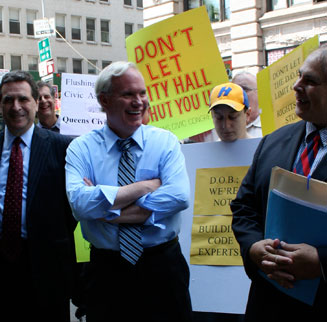
"It's amazing we have to be here once again in front of the most corrupt agency in the entire city," said Avella, while double-decker buses whooshed by. "Illegal construction, out of character construction is out of control in this city, and we are not going to let the mayor and the Department of Buildings let the real estate industry have its way."
Since 2002, the Bloomberg administration has steered 96 rezonings through the City Council, some of which will drastically change the character of certain neighborhoods. That development plan is the linchpin of Avella's candidacy. Avella claims the administration has stonewalled communities, leaving them on the sidelines as it plans to bring in luxury condominiums and out of character development to neighborhoods across the five boroughs.
If elected, Avella says he would put development in control of local community boards, essentially giving them veto power over what's in and what's out of neighborhoods. When asked whether that would be NIMBYism run rampant, Avella says people are smarter and more understanding than you think.
"He prides himself in fighting for smaller development and downzoning communities in the city," said Land Use Committee Chair Melinda Katz, who often has to work with Avella. "I think it’s a goal that most people want to see in the city of New York."
The idea is popular among many of the city's community development advocates. Some of them hope an Avella candidacy will get this type of community development approach on the agenda of the next administration.
"I think Avella is bringing up some very, very important ideas and important issues which no one else is talking about," said Simeon Bankoff, executive director of the Historic Districts Council. "I don’t hear the mayor talking about his plans for the city. I hear him talk about education. I hear him talk about guns. I don’t hear him talk about neighborhoods the way I talk about them."
Whether Avella will be able to capitalize on the groups that are against the Bloomberg administration's development approach is unclear. While the anger may be there, Avella's ability to harness it is questionable.
Avella's 09 Role
There are some places where Avella fits in.
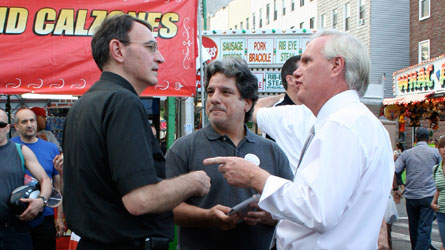
Earlier this month in Williamsburg at the Italian Festa del Giglio, the candidate weaved through the crowds, undaunted by the smell of cannolis and the sausage and peppers sizzling.
While making his way through, Avella turned to his campaign confidant, Phil DePaolo. "You know my crowd," he said with a smile.
"That's why I wanted you to come," DePaolo, president of the New York Community Council, replied.
Just a half hour before, Avella had been attempting (emphasis on attempting) to court the voters of Williamsburg disembarking from the Bedford Avenue subway stop. Note: The young and hipster laden population seemed far more interested in getting to the local watering hole than shaking Avella's hand.
But here on North 7 Street, flooded with Catholic Italians, Avella felt right at home.
If there are any areas that Avella will be able to carry come this fall's primary, it's the ethnic enclaves, said one city political consultant. They won't carry him into the general election, Mercurio says, but Avella might be able to win the votes of New Yorkers who, whether they want to admit it or not, would not vote for a black candidate, like Thompson.
Other than that, Mercurio said Avella's real influence on this year's Democratic primary is giving Thompson the opportunity to get his name out early.
"The favor Tony Avella is doing in this campaign is to allow Thompson to have an opponent in the primary, to allow him to do a media campaign in the primary," said Mercurio. "The Tony Avella race is basically an opportunity for Thompson to get matching funds in the primary."
When asked if Thompson considered Avella a threat, a campaign spokesperson only said that Thompson had garnered support from other mayoral hopefuls, like Weiner.
Either way, Avella, isn't giving up.
"I'm not the phony politician that says, 'I'm gonna win this. We're gonna win this,'" Avella says, sitting in his tiny campaign headquarters, his fist clenched pounding the air. " I don’t believe in that. I'm the honest guy. I'm telling the truth. We can win it. Are we definitely going to win it? No, that's too egotistical for me."
Clarification: Tony Avella has been endorsed by the League of Humane Voters of New York, not to be confused with the New York League of Humane Voters.
Replacing Miguel Martinez
A little after 10 a.m. Monday, Miguel Martinez's re-election campaign conducted its last official duty: It delivered approximately 3,000 signatures to the city's Board of Elections, presumably to get the councilmember on the ballot for a third term.

Two days later, the campaign broke out the "white-out."
Sub in: former councilmember Guillermo Linares, freshly resigned as the city's commissioner for immigrant affairs, who swooped in a day after Martinez's resignation to take his signatures and, more importantly, his place on the ballot.
Martinez resigned on Tuesday and pleaded guilty on Thursday to fraud and money laundering, making him the first elected official to fall from the City Council's slush fund scandal. His abrupt departure triggered an obscure section of election law, which spurs a three-member committee, all appointed by Martinez, to select a replacement candidate.
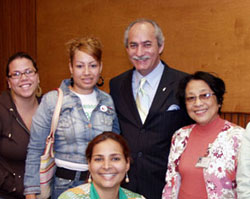
The move in some areas of the Upper Manhattan district promises to create ballot warfare as opponents claim Linares' latest candidacy is illegal and misrepresents the intent of thousands of voters who signed petitions for the now shamed Martinez.
For more on how the city's petition process works, play Gotham Gazette's latest game: Bump.
A Legal Replacement?
About 306 pages, each with 10 John Hancocks, would now go to Linares. Representatives for the lead insurgent candidate, Ydanis Rodriguez, say they should all be thrown out.
"The petitions are circulated and they say Miguel Martinez on them," said Leo Glickman, Rodriguez's attorney. "No one that signed that petition was interested in putting Guillermo Linares on the ballot."
Reportedly, the Martinez camp was shopping for a new candidate last week, which could call into question the intent behind the campaign's petition filing on Monday -- three days before the deadline. Already his opponents are questioning whether the petitions filed early last week were ever meant to ensure a Martinez candidacy.
"Councilmember Martinez knew this was a possibility," said Glickman, referring to the former elected official's plea bargain on Thursday. "Rather than being honest they are trying to trick the public."
The Rodriguez campaign is formally challenging the petitions at the Board of Elections in hopes of getting Linares thrown off the ballot. Glickman said he expects the board will have a hearing on the challenge next month.
Other candidates in the district, which stretches across Inwood and Washington Heights, agree that the inclusion of Linares on the ballot makes the race unfair.
"This is not the right thing to do," said Cleofis Sarete, who had tried to get on the ballot. "If he wants to come back and run for City Council, he should go through the process. He should go and collect his own signatures."
But the state's election law may differ. According to the city Board of Elections, a selection committee is tapped if a vacancy occurs after a candidate's petitions have been filed (in Martinez's case it occurred a day later). As long as the petitions are accurate and there are enough valid signatures, this three-member committee can select anyone to fill the spot -- regardless of the circumstances triggering the vacancy.
Calls to Linares's reported spokesperson at the Mirram Group went unanswered, and his election lawyer, Henry Berger, refused to answer questions about his candidacy.
Linares Versus Martinez
Last triggered following the assassination of City Councilmember James Davis in 2003, this particular section of election law doesn't raise as much ire among good government groups as it does among the district's candidates. Though the circumstances revolving around this incident differ greatly from the Davis vacancy, some voting and good government organizations say there still should -- in all circumstances -- be a back-up plan in case a candidate can't run or, as in 2003, dies.
"There is always a committee on vacancy," said Gladys Krasner, co-chair of the League of Women Voters of the City of New York. "Anything can happen. They can drop dead. It doesn’t have to be a scandal."
Filling a vacancy on the ballot is not like filling a vacancy in office, advocates say. The final decision is still left up to voters.
That final decision may now be affected by the connection between Linares and Martinez. Even if Linares stays on the ballot, his road back to 250 Broadway could be a rocky one.
The vacancy committee that selected Linares, which includes Even Marie Santana, Placido Rodriguez and Agusto Diaz, was hand-picked by Martinez. The connection, some say, could taint the candidacy of Linares, who was the first Dominican elected to the City Council in 1991.
"There is certainly going to be an albatross around Linares's neck," said Gene Russianoff of the New York Public Interest Research Group.
Recession Adds New Meaning to 'Struggling Artist'

New York's artists have always lived in a state of flux. Up-and-coming artists from around the world have seen New York as the ultimate destination spot. Once here, they often have been urban pioneers -- establishing creative enclaves in what had been derelict and industrial neighborhoods. Then the artists often lost their homes and studios as those areas became playgrounds for hungry developers.
The current economic climate has only exacerbated the artists' struggle, forcing them to reevaluate their options. As galleries close and art nonprofits suffer from cutbacks in funding and the loss of support from private institutions, artists must look for new outlets and resources in order to sustain themselves. Many have discovered alternative channels for showcasing their work and staying afloat financially.
Cutback, Cutback, Everywhere a Cutback
The art community has been hit particularly hard by the economic downturn. Although some artists support themselves solely on the sale of their work, the vast majority supplements their incomes with temp work, doing graphic design or teaching. But much of this employment has disappeared as a result of the recession. The New York Foundation of the Arts recently conducted a statewide survey on how the recession is affecting artists and found that many have lost their jobs and are struggling to afford studio space and materials on top of covering their daily living expenses.
Jackie Battenfield, a visual artist and professor of professional development classes at Columbia University and the Creative Capital Foundation, has first-hand experience with the challenges artists face during these tough economic times and just wrote a book entitled, The Artist's Guide: How To Make A Living Doing What You Love.
"First of all, many artists subsist at the margin. Most artists will only earn enough at an outside job to pay the bills -- they don't earn extra because to do that would mean giving up time from their art," she explained in a phone interview. "They also have more expenses than the average person since they have to make whatever they earn cover their art practice, so they are under-employed to begin with."
Battenfield and others predict that the high cost of living in New York and waning job opportunities will result in a decrease in the number of young art school graduates moving to the city, although no one knows for sure. The executive director of New York Foundation for the Arts, Michael Royce, explained, "We found that people are not moving out of their homes to reside in another state more friendly to their needs but rather are moving out of their homes because they can't afford the rent or mortgage payments and into the homes of family members or friends."
To make matters worse, many artists have lost representation, as more galleries have tightened their belts or shut down. Over the past year, several galleries have had to close including Bellwether Gallery, Cohan and Leslie, Rivington Arms and 31 Grand, while the Zach Feuer Gallery dropped half of its artists. With less opportunity to show their work, many established artists are applying to teach, boosting job applications at art schools but not the number of positions available.
The Trickle Down Effect
New York City's cultural organizations also are feeling the heat from the recession. With the cutbacks in funding from the mayor's office and foundations and private corporations scaling back on their support, these organizations are hurting at a time when artists most need their help. The New York Foundation for the Arts directly experienced this rise in demand with a 10 percent increase in applications this year for the unrestricted cash awards of $7,000 the organization provides to artists in different disciplines.
Artists not only turn to the non-profits for support, but many work for these organizations. Due to cutbacks, many nonprofits have let staff go or decreased salaries.
"Funding has definitely been more difficult from private corporations, and there was a slight reduction from the grant from the city," said John Strohbeen, president of the Brooklyn Waterfront Artists Coalition. "But Mayor Bloomberg had to reduce his budget for the current year, and he did cut back on our funding as he did to all of the organizations."
In terms of city funds, things could have been far worse. The Department of Cultural Affairs expected a 16 percent cut, but in the end, saw only a 2 percent reduction in money available for the Cultural Development fund and the Cultural Institutions Group for fiscal 2010.
"The city's fiscal realities mean that funding for agency budgets will be lower for the foreseeable future," explained Commissioner Kate Levin of the Department of Cultural Affairs. "In the meantime, we are doing everything we can to support the 1,400-some cultural organizations that sustain the city's quality of life – especially important during these tough economic times."
Exploring New Avenues
In spite of the economy, there has been growth in some areas of the art market. Both the Affordable Art Fair and The Armory Show reported record-breaking attendance although sales dropped sharply at auctions held in conjunction with the Armory Show. With more than 60 galleries from around the world, the Affordable Art Fair attracted over 10,000 visitors and made over $2 million in sales "I think that it would be fair to say, like anything else in this economy, that there was a volume in sales in lower price work but still all the pieces were selling," said Paul Morris, vice president of MMPI Art Shows & Events.
Making the Best of the Worst
While it is easy to focus on the negative, many artists are transforming their struggle into opportunity, proving tough times can also be a period of remarkable ingenuity.
"I think innovation and creativity is rewarded in this type of situation more than any other. I think when everything is really roaring along, your time is spent capturing the market," said Morris. "It is an opportunity to invent a new paradigm for the art world. If you look at the history of how down markets affect artists, artists are making work for themselves and not for a market."
In Greenpoint, the aptly named FEAST (for Funding Emerging Art with Sustainable Tactics), a recurring communal dinner in a church basement, began in February as a means of democratically supporting emerging, local artists. Open to the public, diners pay for their meal on a sliding scale and vote for one of the proposed artist projects, which is then funded by the proceeds from the dinner and presented at the next FEAST.
"The positive of this economic downturn is that artists are creative -- they're using their resources to band together to do more events on their own. I believe that there will be a lot more alternative and tiny spaces cropping up in low rent neighborhoods around the city just like it did before," Battenfield said.
At a time when most galleries are playing it safe and sticking with their roster of well-known artists, the owner of Envoy Enterprises, Jimi Dams, recognized the need to lend a helping hand and offer exposure to emerging artists. In February, he launched the series, "One Day at a Time," a 24-hour art show exhibiting the work of a different artist each day beginning at 6 p.m.
Open studio tours have become ubiquitous in neighborhoods throughout New York. The budding artist community in Bushwick just put on the third annual Bushwick Open Studios and Arts Festival. This resident-run organization, Arts in Bushwick, not only gives artists the chance to exhibit work, but also aims to promote discussions about preserving the artistic identity and character of the neighborhood and preventing the displacement of local artists and residents.
Cultural non-profits are also providing resources and programs designed to help artists continue their work. The non-profit, The Lower East Printshop has several different residency programs including the "keyholder residency" which offers free 24-hour access to printmaking facilities and materials for one year, in addition to showcasing work in various open studios.
The Department of Cultural Affairs is devising various programs as well. "Given the fiscal realities, we're rolling out a number of initiatives that provide new resources to the field at little cost to the taxpayer," Levin said. "Our goal is to help organizations save money when resources are scarce, provide access to credit and bridge loans, and maintain and grow the communities of volunteers and stakeholders who sustain and nurture organizations, helping them to manage through the downturn and poise them for the future."
The mayor has expanded the Materials for the Arts program with 10,000 square feet of new warehouse space to meet the growing demand for art supplies and to continue to help serve art organizations and public schools. Recognizing the rising unemployment rates among artists, the Department of Small Businesses Services and the Department of Cultural Affairs will allocate $75,000 for a program to train and place art handlers.
The economic downturn might not make living in New York any easier on artists, but they continue to look ahead. A Brooklyn-based visual artist, Baptiste Ibar, said in a phone interview, "I think it is positive, but we're trying to stay afloat. We're building giant rafts in case it is a real flood. Art really has to become this necessary, vibrant part of the community, not just purely a marketing thing."
Nicole Gates Anderson is a freelance writer based in Brooklyn.
